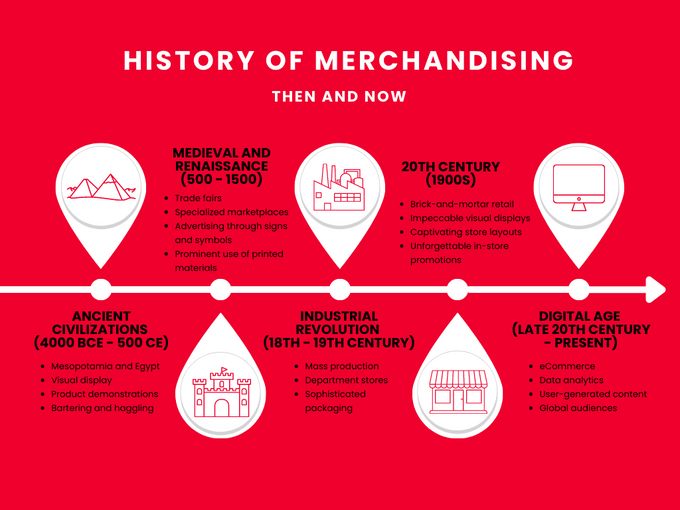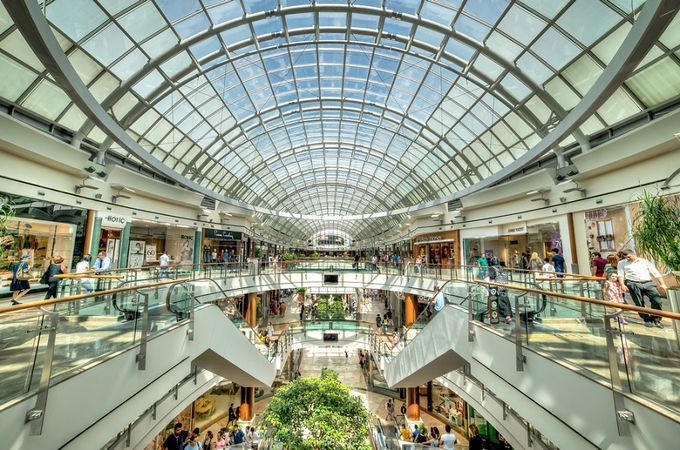History of Merchandising: How Strategies Have Changed
The digital revolution led to a massive shift in the retail industry, giving rise to the booming world of eCommerce and mCommerce. With the birth of online platforms, traditional brick-and-mortar stores faced new challenges and opportunities.
Updated December 12, 2025

When you think of merchandising, you probably think of a modern-day storefront that's online or brick-and-mortar. But what many people don't realize is that the history of merchandising goes back to ancient times. Even in the cradle of civilization, bustling bazaars and vibrant trade routes depended on core merchandising principles to sell and exchange goods.
What is merchandising? Merchandising is a retail approach focused on showcasing products to influence customer decisions and drive sales. It involves presenting items in visually appealing and strategic ways to encourage purchases.
» Learn more in our detailed article on merchandising
Below, we explore the history of merchandising and how strategies have changed through 4 main periods:
- Ancient roots of merchandising
- Visual merchandising history
- Golden age of brick-and-mortar retail
- Digital revolution and eCommerce merchandising
» Looking to get ahead of the curve? Book a demo and learn more about our AI-powered merchandising solution
Ancient Roots of Merchandising
Merchandising and trade go hand in hand—and trade can be traced back to the earliest human civilizations, like Mesopotamia and Egypt. These ancient cultures laid the foundation for commerce and trade practices that continue to shape and influence merchandising as we know it today.
Just picture it: lively marketplace scenes that go on for miles, packed bazaars adorned with exotic goods, and buzzing trade routes connecting villagers from distant lands. In these environments, sellers used different merchandising strategies to make sure their businesses were noticed and patronized:
- Visual display: Merchants skillfully displayed their wares, enticing customers with colorful textiles, fragrant spices, and precious metals.
- Product demonstrations: Merchants often demonstrated the quality and usefulness of their wares to prospective buyers, such as the durability of a tool.
- Bartering and haggling: Buyers and sellers engaged in lively interactions and negotiations until a mutually agreeable exchange was reached.
Visual Merchandising History
The idea of visual merchandising became important in the 19th century, when stores started focusing on how products were arranged to attract customers. Window displays, organized shelves, and thoughtful layouts were used to make shopping more appealing and guide customer attention to specific items. This marked the beginning of using visuals as a key part of selling products.
Why It Matters Today
- Builds first impressions: A well-designed display can immediately capture interest and set the tone for a brand.
- Drives foot traffic: Thoughtful arrangements encourage shoppers to explore further.
- Showcases key products: Highlights high-value or new items for greater visibility.
- Strengthens brand identity: Consistent visuals create a recognizable and lasting impression.
- Boosts conversion rates: Customers are more likely to engage and purchase when products are presented attractively.
» Now that you understand visual merchandising history. Learn how to stay current with visual merchandising strategies
Golden Age of Brick-and-Mortar Retail
Fast forwarding through the medieval period, Renaissance, and Industrial Revolution gave rise to trade fairs, printed materials, mass production, and department stores. The result of these advancements is the 20th century, when brick-and-mortar retail was at its high point. Specialty stores, supermarkets, and grand shopping malls lured in shoppers with:
- Impeccable visual displays
- Captivating store layouts
- Unforgettable in-store promotions
From the bright lights and shiny floors of department stores to the cozy atmosphere of mom-and-pop shops, there was something for everyone. Shoppers loved to browse through aisles of merchandise, interact with friendly salespeople, and take home new purchases.
The golden age of brick-and-mortar retail may be over, but the impact it left on our consumer culture still lives on. From its annual Future Consumer Index, Ernst & Young Global Limited (EY) shared that US consumers are returning to in-store shopping to rekindle the physical and tactile shopping experience.
What does this mean for online retailers?
A bigger investment in omnichannel merchandising can help sellers give their customers the right engagement at the right time. Seamless integration of online and offline shopping experiences is crucial and allows customers to move fluidly between various channels and touchpoints.
» Explore more differences between eCommerce vs retail merchandising
Digital Revolution and eCommerce Merchandising
The digital revolution led to a massive shift in the retail industry, giving rise to the booming world of eCommerce and mCommerce. With the birth of online platforms, traditional brick-and-mortar stores faced new challenges and opportunities. Merchandising strategies swiftly adapted to the online landscape, leveraging technology to enhance customer experiences. This includes:
- Data analytics: A powerful tool that provides valuable insights into consumer behavior, preferences, and trends. Today's retailers harness this information to refine their merchandising approaches and create tailored shopping experiences for each customer.
- User-generated content (UGC): Customer reviews, ratings, and social media interactions influence purchasing decisions. Savvy retailers integrate UGC into their product displays and promotional campaigns, building trust and engaging with their customer base.
- Artificial intelligence (AI): Optimizing your eCommerce store with AI has become a necessity in the highly competitive online world. Artificial intelligence can boost your store's efficiency, leading to more effective personalized shopping experiences that leverage the tailored experiences reminiscent of brick-and-mortar retail while improving your store's navigation and site search capabilities.
» Here's how to harness social proof for more sales
The digital eCommerce merchandising revolution disrupted traditional retail, but it also opened up new doors. Retailers can reach global audiences, operate 24/7, and leverage targeted marketing strategies. The boundaries between physical and digital worlds blurred, making way for concepts like click-and-collect and showrooming.
» Need more merchandising guidance? Follow these eCommerce merchandising dos and don'ts
5 Popular Merchandising Strategies We Still Use Today
1. Upselling and Cross-Selling
Upselling and cross-selling encourage customers to purchase higher-priced items or complementary products. In a physical store, a salesperson skillfully recommends a pricier version or additional products at the checkout counter. But in eCommerce, personalized recommendations and "Customers who bought this also bought [x]" sections take center stage.
» Learn more: Upsell tactics for eCommerce
2. Product Bundling
Product bundling involves grouping related items together and selling them as a package at a discounted price. For example, a hardware store may bundle gardening tools, fertilizers, and seeds to entice gardening enthusiasts. Similarly, an online grocery store may offer a pantry essentials kit with snacks and certain dry, bottled, or canned staples.
3. Personalization
Personalization means customizing shopping experiences to match customers' preferences. In a physical store, salespeople can remember and suggest suitable products during future visits. In eCommerce, personalization algorithms analyze customers' browsing and purchase history to deliver tailored product recommendations. Imagine an online bookstore suggesting books based on your favorite titles or preferred genres.
» See why AI-based personalization is the future of eCommerce
4. Influencer Marketing
Influencer marketing involves collaborating with individuals who have a substantial public following and leveraging their reach to promote your brand. In traditional retail, a beauty store might partner with a local influencer and host a meet-and-greet to attract customers. In eCommerce, a cosmetics brand may partner with a beauty vlogger to promote products via Instagram or TikTok.
5. Store Design
Carefully curating the visual design of your store is a practice that applies to all stores, from the ancient marketplaces of Egypt to the online shopping of today. In eCommerce, presenting your products intelligently (such as with an effective product grid and utilizing categories & collections) goes hand in hand with social strategies like color psychology.
» Need more help? See our beginner guide to visual merchandising and advanced visual merchandising techniques
» Here are 4 key elements of eCommerce merchandising
The Future of Merchandising
It's easy to live our day-to-day lives without realizing how deeply ingrained the history of merchandising is in the fabric of society. From ancient trading routes to the golden age of brick-and-mortar to the digital revolution of automated tools and technologies, merchandising grows and morphs along with us.
Merchandising practices have continuously adapted to meet changing consumer demands and technological advancements. It's likely that the future of merchandising will see the following strategies become common:
- Blockchain & cryptocurrency: Blockchain and cryptocurrency are likely to shape the way online transactions are made. They can offer secure transactions through their decentralized nature and cryptographic security, along with smart contracts that can automate the fulfillment and returns process.
- Voice search: Voice search and voice commerce offers an enhanced user experience through convenience and accessibility, improving product discovery through natural language processing and offering more personalized recommendations.
- Virtual & augmented reality: AR and VR can create virtual showrooms where customers can try on products virtually or visualize how items would look in their homes, improving satisfaction and reducing returns.
» Keep an eye on these future merchandising trends and learn more about our merchandising solutions









